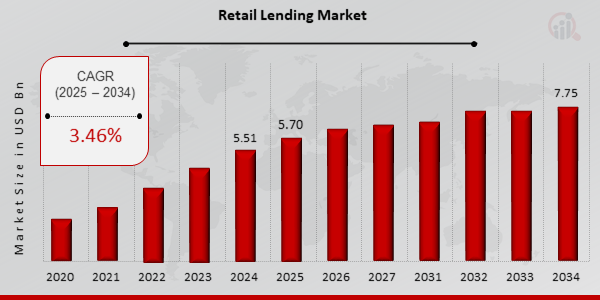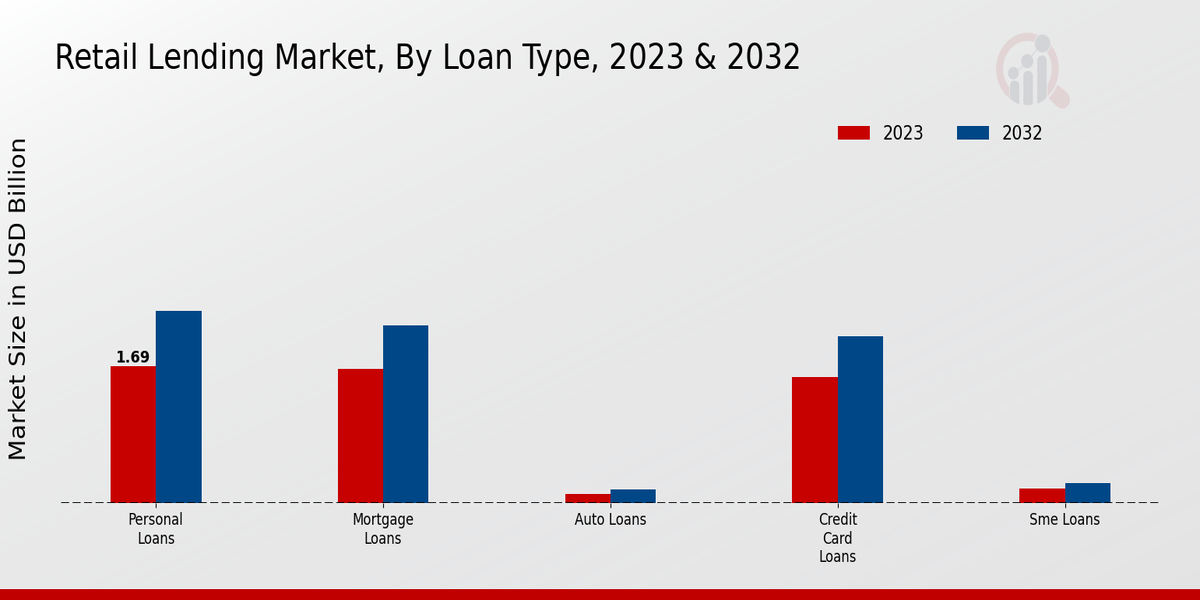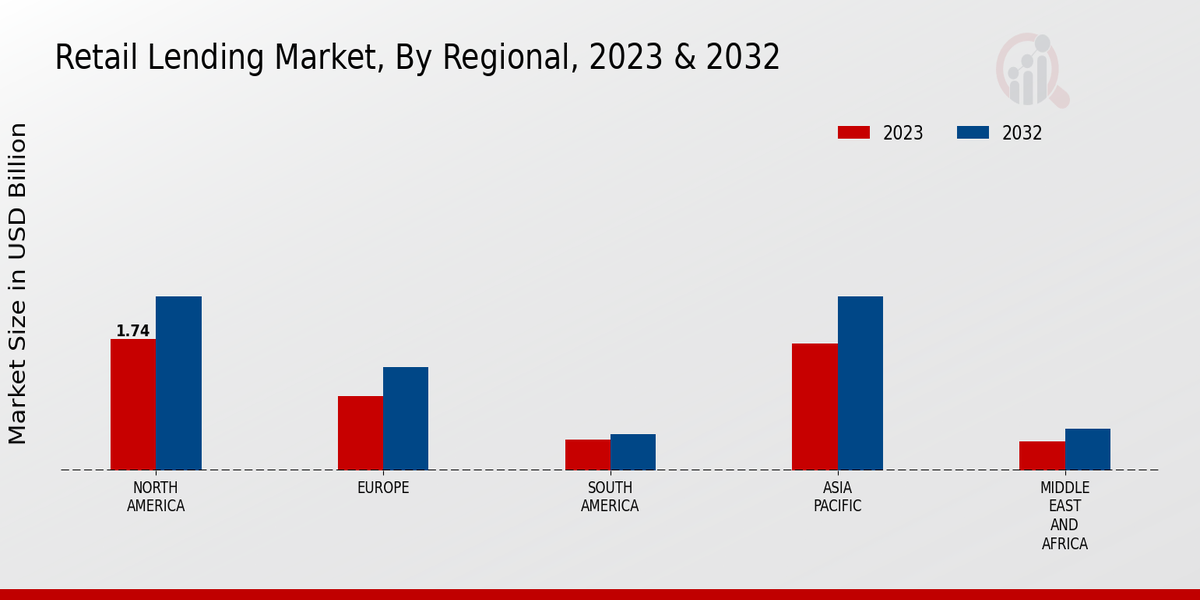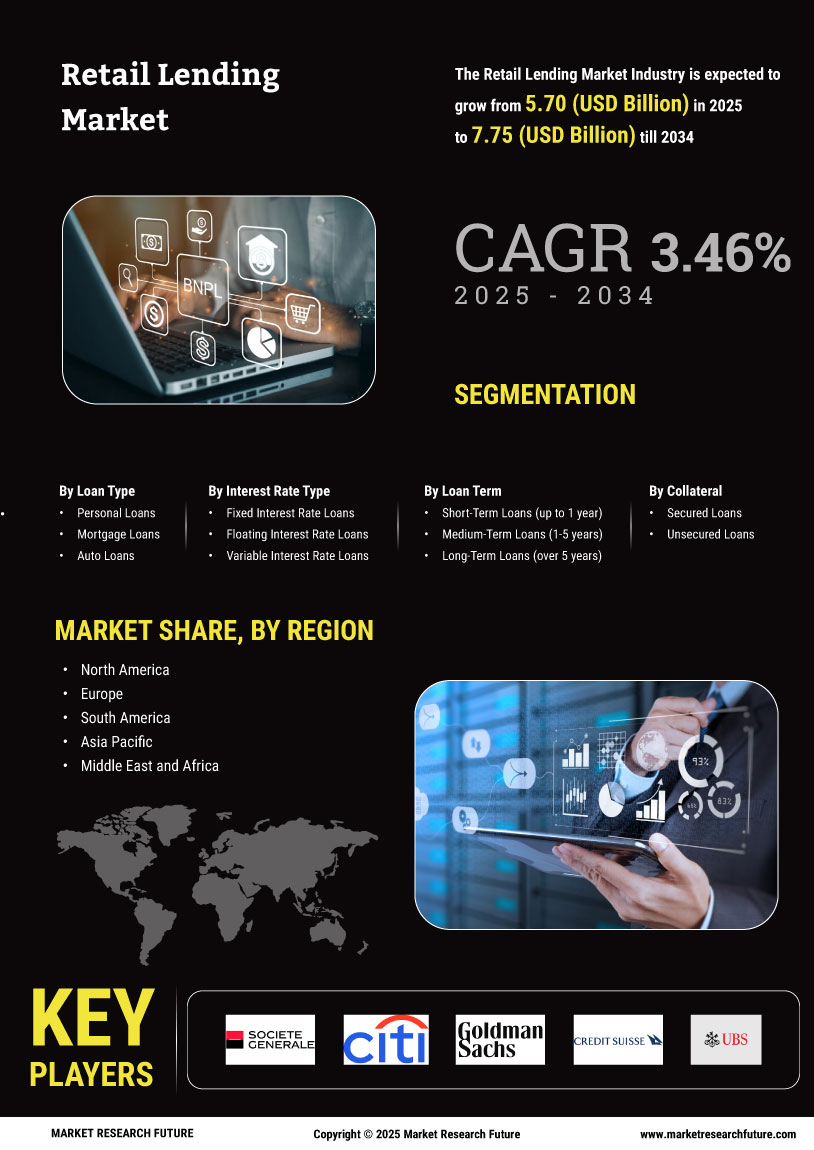Global Retail Lending Market Overview
Retail Lending Market Size was estimated at 5.51 (USD Billion) in 2024. The Retail Lending Market Industry is expected to grow from 5.70 (USD Billion) in 2025 to 7.75 (USD Billion) till 2034, exhibiting a compound annual growth rate (CAGR) of 3.46% during the forecast period (2025 - 2034)
Key Retail Lending Market Trends Highlighted
The Retail Lending Market is witnessing a surge in digitalization, prompting financial institutions to enhance their online and mobile banking platforms. The increasing use of artificial intelligence (AI) and machine learning (ML) enables lenders to automate loan applications, underwriting, and customer service processes, leading to improved efficiency and faster turnaround times. The shift towards personalized lending is another key trend, with lenders offering customized loan products and interest rates based on individual borrower profiles. This trend is driven by the growing demand for tailored financial solutions and the availability of granular customer data. Additionally, the increasing popularity of mobile wallets and digital payments is facilitating seamless loan disbursements and repayment processes, further boosting the adoption of retail lending services.

Source: Primary Research, Secondary Research, MRFR Database and Analyst Review
Retail Lending Market Drivers
Increasing Demand for Personalized Financial Services
The Retail Lending Market Industry is driven by the increasing need of consumers for specialized financial services. As clients become more sophisticated, they demand a greater degree of customization from their banks or others in the financial sector. The result has been the creation and introduction of a wide range of new retail lending products, such as personalized loans, credit cards, mortgages and so on.These products are targeted at different customer segments, such as young professionals, families, and retirees. The growing demand for personalized financial services is expected to continue to drive growth in the Retail Lending Market Industry in the next decade.
Growing Adoption of Digital Banking
Another important driver of the Retail Lending Market Industry is the increasing popularity of digital banking. The modern technologies available in the form of online and mobile banking have made it possible, easy and convenient for people to use a wide range of financial services. There are special applications and websites, and they provide customers with the ability to use a large number of financial products instead of one product, as it was before in many cases.Moreover, digital banking made it possible for financial institutions to offer their customers new and innovative products and services that were not available before. For this reason, one can expect that the increasing popularity of digital banking will remain one of the key drivers of the Retail Lending Market Industry in the future.
Rising Interest Rates
Rising interest rates are a key driver of the Retail Lending Market Industry. When interest rates rise, the cost of borrowing money increases. This can lead to an increase in the demand for retail lending products as customers look to consolidate their debt or finance major purchases. Rising interest rates can also lead to an increase in the profitability of retail lending products, as financial institutions can charge higher interest rates on their loans.The rising interest rates are expected to continue to drive growth in the Retail Lending Market Industry in the coming years.
Retail Lending Market Segment Insights:
Retail Lending Market Loan Type Insights
The loan-type segment of the Retail Lending Market is anticipated to witness significant growth in the coming years. In 2023, the Personal Loans segment held the largest market share, valued at 35.67 billion U.S. dollars. This growth can be attributed to the increasing demand for personal loans for various purposes, such as debt consolidation, home renovations, and medical expenses. The Mortgage Loans segment is expected to grow at a steady pace, driven by the rising demand for residential properties and government initiatives to promote homeownership.The Auto Loans segment is also projected to exhibit growth due to the increasing popularity of car ownership and the availability of attractive financing options. Credit Card Loans are expected to gain traction as consumers opt for convenient and flexible credit options. The SME Loans segment is anticipated to witness a surge in demand as small and medium-sized enterprises seek funding for business expansion and working capital requirements. Overall, the Retail Lending Market is expected to witness robust growth in the coming years, driven by factors such as rising disposable income, increasing access to financial services, and government initiatives to promote financial inclusion.

Source: Primary Research, Secondary Research, MRFR Database and Analyst Review
Retail Lending Market Interest Rate Type Insights
The Retail Lending Market is segmented by Interest Rate Type into Fixed Interest Rate Loans, Floating Interest Rate Loans, Variable Interest Rate Loans, and Hybrid Interest Rate Loans. The Fixed Interest Rate Loans segment is projected to account for approximately 55% of the Retail Lending Market revenue in 2023, making it the largest market segment. The Floating Interest Rate Loans segment is expected to grow at the highest CAGR during the forecast period, as many borrowers are opting for adjustable-rate mortgages and other floating-rate loan products.Variable Interest Rate Loans are likely to register a moderate growth rate, while Hybrid Interest Rate Loans are expected to become more popular in the future. The Interest Rate Type segmentation of the Retail Lending Market allows stakeholders to gain better insights into the prevailing market conditions.
Retail Lending Market Loan Term Insights
The Retail Lending Market is segmented by loan terms into short-term loans (up to 1 year), medium-term loans (1-5 years), and long-term loans (over 5 years). Among these segments, short-term loans accounted for the largest share of the market in 2023 and are expected to continue to dominate the market over the forecast period. This is primarily due to the increasing popularity of short-term lending products, such as payday loans and personal loans, which offer quick and easy access to funds for consumers. Medium-term loans are also expected to witness significant growth over the forecast period, driven by the rising demand for financing for home improvements, education, and other personal expenses.Long-term loans, on the other hand, are expected to experience a relatively slower growth rate as consumers become more cautious about taking on long-term debt obligations. Overall, the Retail Lending Market is expected to grow at a steady pace over the forecast period, driven by the increasing demand for financing from consumers worldwide.
Retail Lending Market Collateral Insights
The Retail Lending Market is segmented into secured loans and unsecured loans based on collateral. Secured loans are backed by collateral, such as real estate or a vehicle, which reduces the risk for the lender and allows them to offer lower interest rates. Unsecured loans, on the other hand, are not backed by collateral, which makes them riskier for the lender and results in higher interest rates. In 2023, the secured loans segment accounted for a larger share of the Retail Lending Market revenue due to the lower risk associated with these loans.However, the unsecured loans segment is expected to grow at a faster rate over the forecast period as more consumers opt for these loans due to their convenience and flexibility. By 2032, the unsecured loans segment is projected to account for a significant share of the Retail Lending Market revenue as the demand for these loans continues to grow. The growth of the unsecured loans segment is being driven by several factors, including the increasing popularity of online lending, the growing number of consumers with poor credit histories, and the rising demand for alternative lending options.
Retail Lending Market Loan Purpose Insights
The Loan Purpose segment plays a crucial role in the Retail Lending Market, influencing market growth and shaping industry dynamics. Debt Consolidation emerged as the dominant segment in 2023, accounting for a significant portion of the market revenue. Home Improvement and Education loans followed closely as major segments, driven by rising consumer spending on home renovations and educational expenses. Travel loans experienced a surge in demand as travel restrictions eased, contributing to market growth. Business Expansion and Medical Expenses also represented notable segments, reflecting the increasing need for capital among businesses and individuals seeking medical treatments.Each segment offers unique market opportunities, and lenders focus on tailoring their offerings to meet specific customer needs and drive market expansion.
Retail Lending Market Regional Insights
The Retail Lending Market segmentation by region includes North America, Europe, APAC, South America, and MEA. The North American region is anticipated to account for a significant market share in 2023 due to the presence of well-established economies like the US and Canada, with a large population base, increasing disposable income, and a favorable regulatory environment. The European region is also expected to contribute substantially to market growth. Factors driving growth in this region include government initiatives aimed at promoting homeownership, favorable interest rates, and a growing middle class.The APAC region is expected to witness the fastest growth over the forecast period due to the increasing population, urbanization, and economic growth. The South American and MEA regions are anticipated to have a moderate market share, with growth opportunities driven by the expansion of the banking sector and increasing consumer demand for retail loans.

Source: Primary Research, Secondary Research, MRFR Database and Analyst Review
Retail Lending Market Key Players And Competitive Insights:
Major players in Retail Lending Market are focused on expanding their geographical presence and product offerings to cater to the growing demand for retail lending services. Leading Retail Lending Market players are also investing heavily in technology and innovation to improve their customer service and efficiency. Key players in the Retail Lending Market industry are adopting various strategies to gain a competitive edge, such as partnerships, acquisitions, and new product launches. The Retail Lending Market development is driven by factors such as rising disposable income, increasing urbanization, and growing consumer awareness about financial products.One of the leading companies in the Retail Lending Market is HDFC Bank. The company offers a wide range of retail lending products, including personal loans, auto loans, home loans, and credit cards. HDFC Bank has a strong presence in India and is also expanding its international operations. The company has a strong customer base and a well-established brand name. HDFC Bank is known for its innovative products and its commitment to customer service.Another major player in the Retail Lending Market is ICICI Bank. The company offers a wide range of retail lending products, including personal loans, auto loans, home loans, and credit cards. ICICI Bank has a strong presence in India and is also expanding its international operations. The company has a large customer base and a strong brand name. ICICI Bank is known for its innovative products and its focus on technology.
Key Companies in the Retail Lending Market Include:
- Societe Generale
- Citigroup
- Goldman Sachs
- Credit Suisse
- UBS
- Rabobank
- Deutsche Bank
- ING
- JP Morgan Chase
- Bank of America
- BNP Paribas
- Wells Fargo
- Morgan Stanley
- HSBC
- Barclays
Retail Lending Market Industry Developments
The Retail Lending Market is projected to reach a valuation of USD 7.0 billion by 2032, expanding at a CAGR of 3.46% from 2024 to 2032. The increasing demand for affordable housing, rising disposable income, and growing consumer awareness of financial products drive the market. Government initiatives to promote homeownership and the expansion of digital lending platforms further contribute to market growth. Recent news developments include the launch of innovative products such as green loans and the growing adoption of artificial intelligence (AI) and machine learning (ML) in credit assessment.
Retail Lending Market Segmentation Insights
Retail Lending Market Loan Type Outlook
- Personal Loans
- Mortgage Loans
- Auto Loans
- Credit Card Loans
- SME Loans
Retail Lending Market Interest Rate Type Outlook
- Fixed Interest Rate Loans
- Floating Interest Rate Loans
- Variable Interest Rate Loans
- Hybrid Interest Rate Loans
Retail Lending Market Loan Term Outlook
- Short-Term Loans (up to 1 year)
- Medium-Term Loans (1-5 years)
- Long-Term Loans (over 5 years)
Retail Lending Market Collateral Outlook
- Secured Loans
- Unsecured Loans
Retail Lending Market Loan Purpose Outlook
- Debt Consolidation
- Home Improvement
- Education
- Travel
- Business Expansion
- Medical Expenses
Retail Lending Market Regional Outlook
- North America
- Europe
- South America
- Asia Pacific
- Middle East and Africa
|
Report Attribute/Metric
|
Details
|
|
Market Size 2024
|
USD 5.51 Billion
|
|
Market Size 2025
|
USD 5.70 Billion
|
|
Market Size 2034
|
USD 7.75 Billion
|
|
Compound Annual Growth Rate (CAGR)
|
3.46% (2025-2034)
|
|
Base Year
|
2024
|
|
Market Forecast Period
|
2025-2034
|
|
Historical Data
|
2020-2023
|
| Market Forecast Units |
USD Billion |
|
Report Coverage
|
Revenue Forecast, Competitive Landscape, Growth Factors, and Trends
|
| Key Companies Profiled |
Societe Generale, Citigroup, Goldman Sachs, Credit Suisse, UBS, Rabobank, Deutsche Bank, ING, JP Morgan Chase, Bank of America, BNP Paribas, Wells Fargo, Morgan Stanley, HSBC, Barclays |
| Segments Covered |
Loan Type, Interest Rate Type, Loan Term, Collateral, Loan Purpose, Regional |
| Key Market Opportunities |
Digital Lending Expansion Growing ECommerce Adoption Underserved Customer Segments Credit Risk Assessment Advancements Personalization and Customization |
| Key Market Dynamics |
Rising Disposable Income Digitalization of Banking Growth of E-commerce Increasing Demand for Personal Loans Government Regulations |
| Countries Covered |
North America, Europe, APAC, South America, MEA |
Frequently Asked Questions (FAQ) :
The Retail Lending Market size was valued at USD 5.51 billion in 2024 and is expected to expand at a compound annual growth rate (CAGR) of 3.46% from 2025 to 2034.
The key regions in the Retail Lending Market include North America, Europe, Asia-Pacific, and the Rest of the World. Asia-Pacific held the largest market share in 2023, accounting for over 35% of the global market.
The major applications of Retail Lending include personal loans, auto loans, credit cards, and home equity loans. Personal loans accounted for the largest share of the market in 2023, followed by auto loans.
The key competitors in the Retail Lending Market include JPMorgan Chase & Co., Wells Fargo & Company, Bank of America Corporation, Citigroup Inc., and The Goldman Sachs Group, Inc.
The key trends in the Retail Lending Market include the increasing adoption of digital banking, rising demand for unsecured loans, and growing popularity of alternative lending platforms.
The key challenges in the Retail Lending Market include intense competition, regulatory changes, and economic uncertainty.
The key opportunities in the Retail Lending Market include growing demand for credit in emerging markets, increasing use of data analytics, and expanding partnerships with fintech companies.
The future outlook of the Retail Lending Market is positive. The market is expected to continue to grow in the coming years, driven by increasing demand for credit from consumers and businesses.
The growth of the Retail Lending Market is being driven by several factors, including increasing disposable income, rising consumer confidence, and expanding access to credit.
The Retail Lending Market is segmented by type, application, and geography. By type, the market is segmented into personal loans, auto loans, credit cards, and home equity loans. By application, the market is segmented into consumers and businesses. By geography, the market is segmented into North America, Europe, Asia-Pacific, and the Rest of the World.

















